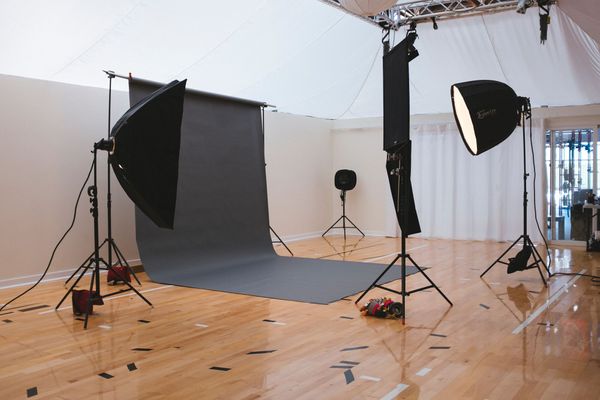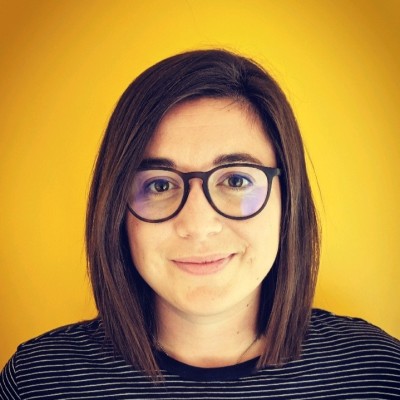Any setting will come with its own ambient lighting to consider. That ambient light can make your job much easier, or a whole lot more challenging, depending on the setting you choose. Pay attention to the backdrop, too. Is there anything reflective, or with the potential to create distracting glare?
You need to know what you’ll be working with — never go into a filming location blind, completely unaware what kind of lighting it has. For example, you’ll be headed to company headquarters to film with the CEO, ask for as many pictures as possible of the location where you’ll be expected to film.
If possible, let the room do the work for you by choosing a space that has plenty of natural light.
2. Natural light — the gold standard
That means that optimizing your lighting setup will be about making the most of the natural light you have, or recreating it using your own lamps, bulbs, and lighting sources.
- If you’re filming outside, make sure to shoot with the light behind you as you’re filming, so that it’s directly illuminating your interview subject.
- If you’re indoors, film with your subject facing a large window if you can.
However, you won’t always be lucky enough to film in the right time and place to have access to plenty of natural light. That’s where your lighting setup comes in.
3. Three-point lighting — a beginner’s guide
A 3-point lighting setup provides you with everything you need to make sure your subject is well-lit from multiple angles. That’s what creates bright light, and a beautiful video.
The three ‘points’ of your video lighting kit are the key, fill, and back lights. Here’s what you need to know about each.
- Key light is the main light source that provides most of the illumination on your subject. It’s placed directly in front of the person you’re interviewing (although not too close), and will be the brightest, most powerful light source you have. If you’re lucky enough to be filming in a room with plenty of natural light, a window makes a wonderful key light. Ring lights are one very popular key light for interviews that makes your subject look great.
- The fill light does just what it sounds like — it fills in any harsh shadows or dark areas cast by your key light. Your fill light should be softer, and more diffused than your key light. It’s even possible to use one light source as both, by using a reflective surface or bounce card to catch some rays from your key light, and shine them back on your interviewee from another direction.
- The back light, just as you might think, sits behind your subject. It’s sometimes referred to as a hair light, rim light, or edge light. The back light will help your captured image feel a little more dimensional, and create a good depth-of-field to separate the person you’re filming from the background. Without background lighting, things can start looking a little flat.
A well-lit interview comes down to finding a good balance between your fill, key, and back light.
4. Find the balance
Once you’re all set up to film, don’t be afraid to take your time and adjust your lighting sources until they’re perfect. You’ll likely want to tweak the brightness, positioning, and softness of your lights — and if you’re working with natural light, that could be as simple as moving closer or further away from a window.
Here are a few things to watch for when you’re trying to get that balance just right.
- If the balance of your key, fill, and back light is off, the lighting on your subject can appear either harsh, too flat. Harsh lighting is caused by a keylight that’s either too bright, or too close to your subject, casting harsh shadows that your fill light can’t possibly smooth out.
- On the other hand, if your key light isn’t strong enough, your interview subject will look drab and one-dimensional. They’ll be lit more by the ambient light in your filming room than the lighting kit you worked so hard to set up.
Getting the right balance is just a matter of adjusting that key, fill, and back light until whoever you’re filming looks great on screen. If you want to give yourself an extra leg up, consider getting a light meter. This is a tool that measures the light levels wherever you’re filming. To make it easier to adjust your video lights, you might want a light stand or tripod so that you can position them at whatever height and angle you want.
Lighting design is more of an art than a science. So be patient with yourself, and make sure to build in a little extra time on filming day to adjust the lighting.
5. Hard and soft lighting
It’s not just the positioning and wattage of your lights that matters — it’s also whether they’re hard or soft. But since light is an intangible wave (and/or particle), what does that actually mean?
Well, it’s to do with the size and shape of your light source. Hard lights are small and bright, emitting a single point of light. These may or may not come with a lens (like a Fresnel lens) that can be used to focus and angle the beam of light. Different types of lights will have different levels of hard or softness, such as fluorescent (or compact fluorescent) halogen, LED, or incandescent light.
Soft lights are larger, usually square or rectangular light panels. The light they emit is more diffuse and flattering, so they will be your go-to for key lighting. The larger your soft lights are, the more gentle, radiant and non-directional their glow.
However, hard lights can actually do double duty. If you filter them through a tool like a diffuser, softbox, light reflector, or even silks, they’ll soften and become your principal key light, too. Some videographers use specifically designed tools like a beauty dish or umbrellas for this purpose, too.
Because hard lights are so versatile, not to mention smaller and more portable, they might be your best bet when you’re first building your lighting kit. Try checking out the hardware-store when you’re looking to get the basics!


